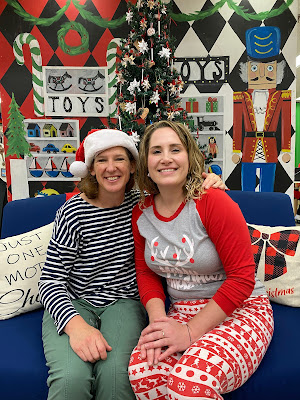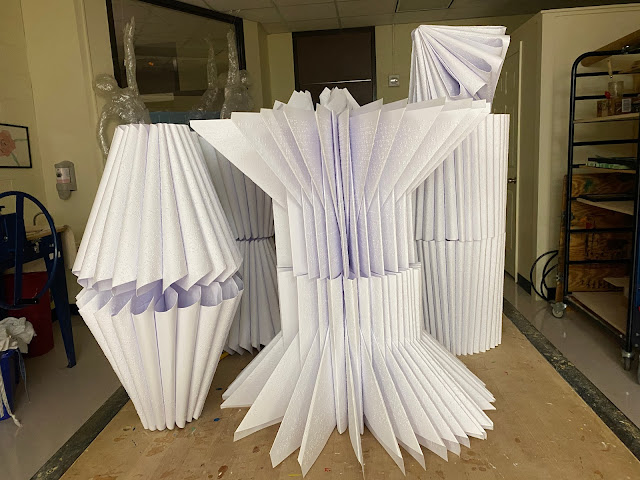Friday, December 22, 2023
Sugar Cookie Creativity
Wednesday, December 20, 2023
Student Christmas Craft Sale
 The last week before Winter Break, my students printed rubber stamp gift cards, painted wooden sleds and sleighs and trees, collaged tactile Christmas cards and melted wax and molded candles. The projects were small enough that they could be done within a class period or two and everyone could pick the type of craft that interested them the most. We set up one table of those craft items ranging from 25 cents to 6 dollars, and ended up making $200 hours within an hour. We're going to use it for something fun like pizza.
The last week before Winter Break, my students printed rubber stamp gift cards, painted wooden sleds and sleighs and trees, collaged tactile Christmas cards and melted wax and molded candles. The projects were small enough that they could be done within a class period or two and everyone could pick the type of craft that interested them the most. We set up one table of those craft items ranging from 25 cents to 6 dollars, and ended up making $200 hours within an hour. We're going to use it for something fun like pizza.
Painting Party Backdrops
We had another couple of large panels and a smaller tree at a seating area for students to take selfies and group shots throughout the party. By the time you add music and food to the decorations, you've got yourself a party! High School students are more likely to participate in karoake and dancing then middle school students, so we set up games like twister, giant Jenga and Connect Four for smaller group activities. The photo booths were a hit regardless of age. Everyone had a blast!
Another fun backdrop for Santa photos included three yard reindeer with twinkling lights, a plywood sleigh made by a friend from church, and cardboard trees that we painted for a dance years ago. This set up was a hit at two separate parties! It's worth putting in a lot of effort into one year of building so that future years are just a matter of repainting and tweaking!
Spin Art
Cyber Security Posters
 Drawing is a huge part of these kind of contests, but it is where we generally fall short in a school with visual impairments, some of whom only read Braille. Rather than focusing on coloring and typography most of our students used the computer and printed the text for their posters. Then they collaged most of the shapes to give bring color and contrast without crayons and colored pencils. I think they came up with some cute ideas.
Drawing is a huge part of these kind of contests, but it is where we generally fall short in a school with visual impairments, some of whom only read Braille. Rather than focusing on coloring and typography most of our students used the computer and printed the text for their posters. Then they collaged most of the shapes to give bring color and contrast without crayons and colored pencils. I think they came up with some cute ideas.Tuesday, November 14, 2023
Community Outreach with and for my Students
Sunday, November 5, 2023
Clay heads: Expressions
In an one hour hour lesson, my students were able to learn about facial proportions, expressions, and the ceramic techniques of making a pinch pot, slipping and scoring.
Saturday, November 4, 2023
Curly Paper Wigs

Sunday, October 29, 2023
Painted Aprons for Chili Cook-off Winners
Autumn is the season of Chili Cook-offs. Instead of spending a lot of money on trophies that people don't want to have to store, why not give them something useful to go with their bragging rights, like a set of wooden spoons or an apron. For an upcoming Chili cook-off I thought I'd give first, second, and third place winners aprons upon which I painted cooresponding number of chilis. Aprons were about $3 each. It's easy to copy chili shapes from images online, or you can trace a real chili in pencil if you've got one handy. I painted the silhouette with black acrylic and when it dried, I painted the topcoat of red or green acrylic, leaving some of the black show through for hatch marks. It's funky, fun, washable, and a conversation piece. I hope the winners can use it to brag about their win at cookouts for years to come.
Friday, October 27, 2023
Inktober 2023
 I love the exercise of bouncing ideas around. For "dodge" I thought of a Dodge (car), a game of dodgeball, a Dodge playing dodgeball... and within a few seconds, I was asking myself questions about what kind of things could be thrown at each other besides balls. I settled on a snowman and the headless horseman from The Legend of Sleepy Hollow hurling and dodging each other's make-shift heads. "Map" can just be a map, while also being a topographical landscape to be explored.
I love the exercise of bouncing ideas around. For "dodge" I thought of a Dodge (car), a game of dodgeball, a Dodge playing dodgeball... and within a few seconds, I was asking myself questions about what kind of things could be thrown at each other besides balls. I settled on a snowman and the headless horseman from The Legend of Sleepy Hollow hurling and dodging each other's make-shift heads. "Map" can just be a map, while also being a topographical landscape to be explored.Monday, October 23, 2023
Sculptures from Braille Books
 Book folding is a fairly new trend in wall art. Patterns can be found online, which give the number of pages and the number of inches from the top and bottom of the page to fold in order to make specific shapes like hearts or diamonds. For those creative souls (like my students) who want to explore their own folding techniques, the sky is the limit! Obviously most books are printed on paper, but Braille books are embossed on card stock, giving extra strength with fewer pages. I demonstrated a couple of folding ideas before letting students try out their own ideas with discarded Braille books. The fact that they are held together with staples and don't have any hard covers or spines to deal with, make them extra conducive to sculpture in the round. It didn't take long to get some great results.
Book folding is a fairly new trend in wall art. Patterns can be found online, which give the number of pages and the number of inches from the top and bottom of the page to fold in order to make specific shapes like hearts or diamonds. For those creative souls (like my students) who want to explore their own folding techniques, the sky is the limit! Obviously most books are printed on paper, but Braille books are embossed on card stock, giving extra strength with fewer pages. I demonstrated a couple of folding ideas before letting students try out their own ideas with discarded Braille books. The fact that they are held together with staples and don't have any hard covers or spines to deal with, make them extra conducive to sculpture in the round. It didn't take long to get some great results.Sunday, October 22, 2023
From Tennis Camp for the Blind to Insights Art Show and APH trip
 |
| APH president & my student |
 |
| Ticket to the IMAX in Braille |
They also attended a pre-screening and Q&A session for the Netflix Original "All the Light You Cannot See" at the Kentucky Science Center. It's coming to Netflix in November and I highly recommend it. It's so refreshing to have a blind protagonist played by blind actresses (both old and young versions).
 |
| Nick Doyle's solo show in denim at KMAC |
Orientation and Mobility (O&M) experiences were everywhere: navigating TSA, flying on a plane, the plane train, an Uber, a charter bus, escalators, elevators, moving sidewalks, and miles of city sidewalks. Other life/ learning experiences included being interviewed for a podcast, networking at the reception, eating a meal with three forks and three plates, and shaking hands with the APH president in front of 400 people. It was an amazing trip!

I helped students cook s'mores over a campfire, go on scavenger hunts, play games (hide and seek was especially entertaining), and go swimming.
Tactile Student Face Ornaments
December will be here before you know it, which means, it's time to design our Christmas tree for the Museum of Art and Science's Festival of Trees. I always try to use the tree as a way for my students to advocate or help the community understand them and their disability better.
Sunday, October 1, 2023
Pencil Cup Project from Recycled Materials
My Elementary School and Middle School students have been learning how something as flat as a piece of paper can be turned into something 3D by looping strips into links of a chain or folding pages of a book to make a sculpture, or quilling folded paper to make framed images. Making pencil cups is another project that teaches a one more technique of making flat magazine pages into a tactile exterior to a pencil cup. It is an easy, fun project that can be used for years, rather than tossed after a month of hanging on the fridge.
Students found magazine pages which they rolled into a tube, using a pencil, drizzling a strip of Elmer's glue to secure the edge. For stiff covers, rubber bands would hold it the tube in place until the glue dried, and with tight rolls a second pencil would be used to scoot the first pencil out of the tube. The each rolled tube was hot glued to a clean tin can, transforming waste from the recycled bin to something you can use to organize pens, pencils, markers, scissors, and paint brushes. Children can learn to think through the side and direction they want to roll their pages to get the nicest edge, and how to organize their colors and patterns on the can. The next rainy day at home with a bored child, consider having them make one of these to spruce up their bedroom.
Thursday, September 28, 2023
Fall Student Art Show
The fact that we've been studying repetition, pattern, and unity made for a coherent and colorful body of work. We used some of our zentangle portraits for show posters and invitations, made commercials for the morning news, and cookies for the opening reception. Turn out was better than we'd seen in years and the students felt great about being able to put together a body of work in a short period of time.
Textured Caulk Paintings
Monday, September 18, 2023
Analogous Rectilinear Cardboard Relief Art
Saturday, September 16, 2023
Zentangle Portraits
To build on our pattern lesson and give our doodles something to do, my students created what I call "zentangled portraits." They used a picture of themselves, a friend or a model in a magazine, cut out only the neck and face, following the hairline and collaged to a larger piece of paper.

Some images took on royal or saintly mantles as the background was broken up with halos, arches, and crowns, and those spaces were filled with repeated marks from black sharpies. Some kept encorporated colored paper, markers or colored pencil to add another layer of complexity.
Students who were blind, used Wixi Sticks to divide the space, and then stayed within each shape filling it marks such as stripes, O's or X's. I love the pattern-saturated surfaces of Gustav Klimt paintings and I love the way this assignment turned out.








































